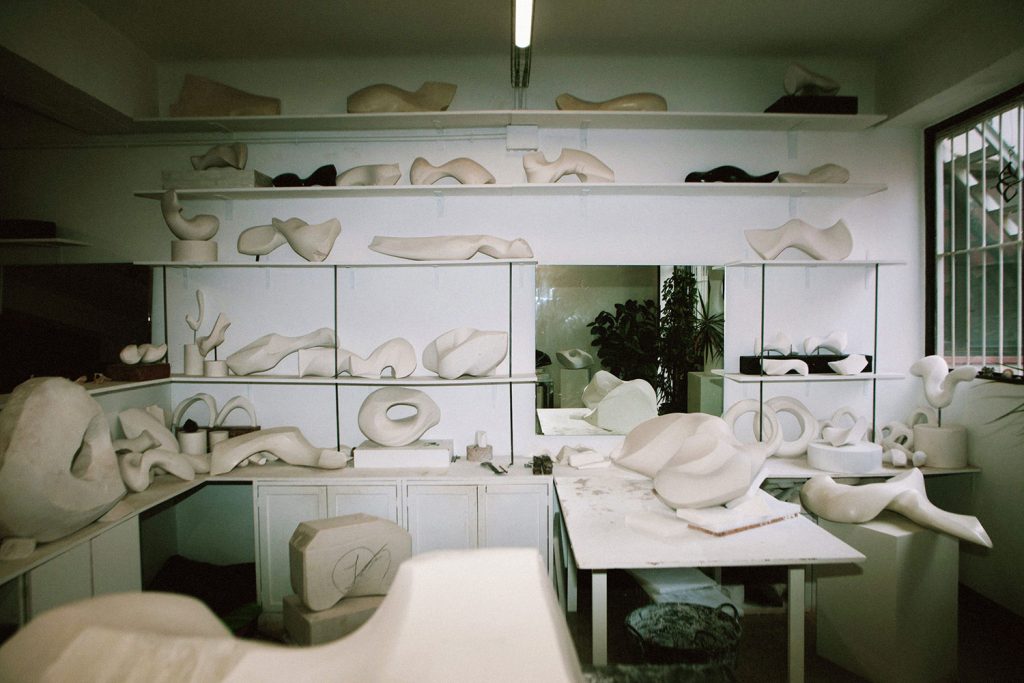WORDS AND INTERVIEW BY CARLOS ÁLVAREZ PHOTOGRAPHY COURTESY OF THE ARTIST AND MANU DA COSTA STARRING @SOPHIE_ELIZABETH_THOMPSON BARCELONA SPAIN
There are art exhibitions that can change your life and that is exactly what happened to Sophie in 2005 when she flew from England to see a retrospective exhibition at the MACBA in Barcelona, Spain, An exhibition of the work of Antoni Tàpies, one of the great masters of painting at the end of the 20th century. In love with its architecture, countryside, light and culture, she decided to take a step further in her career and set up her studio and residence in Barcelona, where her figure as a sculptress has crossed borders and oceans.
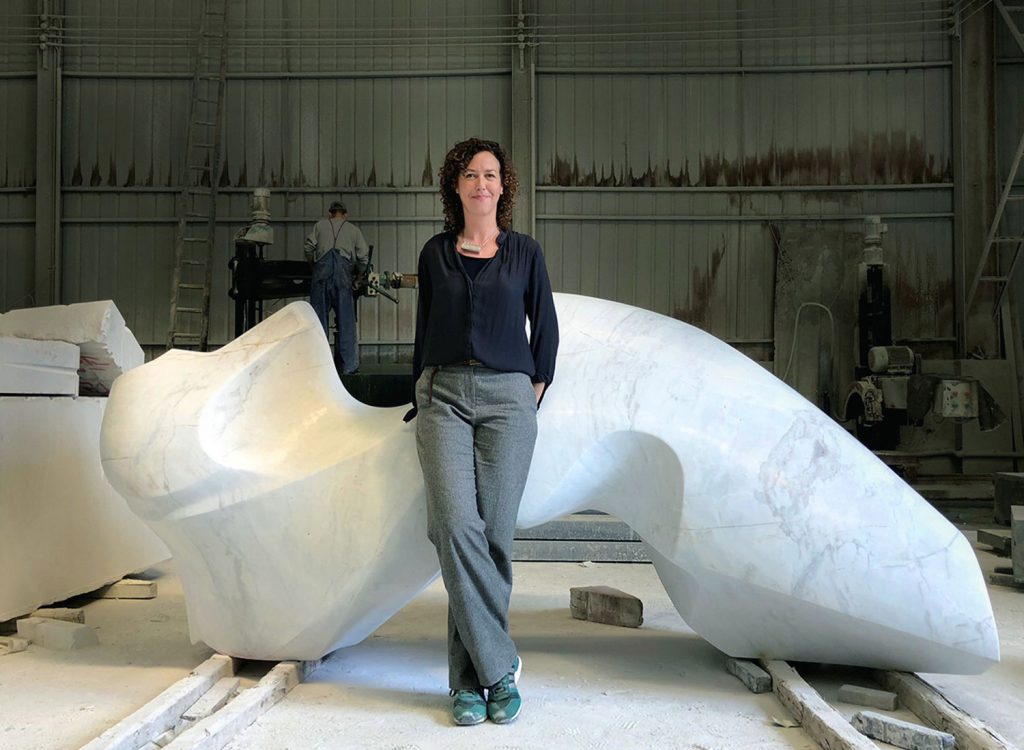
To enter Sophie’s studio is to enter a space of light, where white envelops everything you see and where the smooth surfaces of her sculptures meet creating fine and beautiful edges that define her pieces, offering a total sensation of calm and harmony to the space. Looking up we find an endless number of plaster prototypes that fill the shelves that run along the wall and that invite us to navigate among their curves. As I walk through the Studio I come across beautiful Carrara marble sculptures that seem to dance on pedestals, in this beautiful dance, we find majestic sculptures in black Marquina marble that contrast with the predominant white, as well as the area where Sophie works on different pieces that she models in Clay and where the earthy colours splash against the white.
Since when did you feel you wanted to be a sculptress?
When I was little. Yes, yes, when I was little, I was already fascinated by sculpture.
Do you remember making figures with clay or other materials when you were a child?
Yes, when I was little, I used to play and want to make things. My grandmother painted, my mother painted, my sister is a make-up artists, so when I was little I always loved to draw or I was doing something, I remember whittling sticks with a pocket penknife and making, well nothing really really well, yeah, just crap!!!! But I always enjoyed doing something and always with my hands.
We could say that being a sculptor is a vocation.
Yes, I always think in 3D. When I work, you know, sculpture is very tactile and the hands are other like eyes for me. I look at spaces a lot and think about the objects in spaces and yeah, I definitely think in 3D.
Over the years you have used materials such as clay, marble and bronze for your sculptures. Are there another element as light, sound, water that you use when you are creating?
Well, I actually have a project in mind where I want to use all this because my work is very much about being present. I think my work always is, because you have to be present to create it or certainly in this kind of work. So for me, I have a project in mind that will, that will use and explore all these different elements.
In your work, the human or animal figure is recognisable. Can we find pieces in which there is only a thought or a feeling?
They are all, all my pieces are just, just a feeling. But I think, I think it was Henry Moore who said that all sculpture comes from the human figure. And I think he’s probably right actually. I used to say no, but I think he is. I mean, I would say this is quite figurative, really. I mean, I can’t say it’s not. And I always look at a sculpture afterwards and that’s when I see different parts and that’s when I think “ah, that’s it!” This happens because I’m working very spontaneously and in the present moment, going with what I feel and not thinking so much about what I have to do, I do everything I can to get out of my own way, so I’m not thinking. But then, for example, look at this curve, it reminds me of Floss. We used to have a greyhound, we have one now, but he’s more a lurcher. Floss had this very soft part in the curve of her stomach.
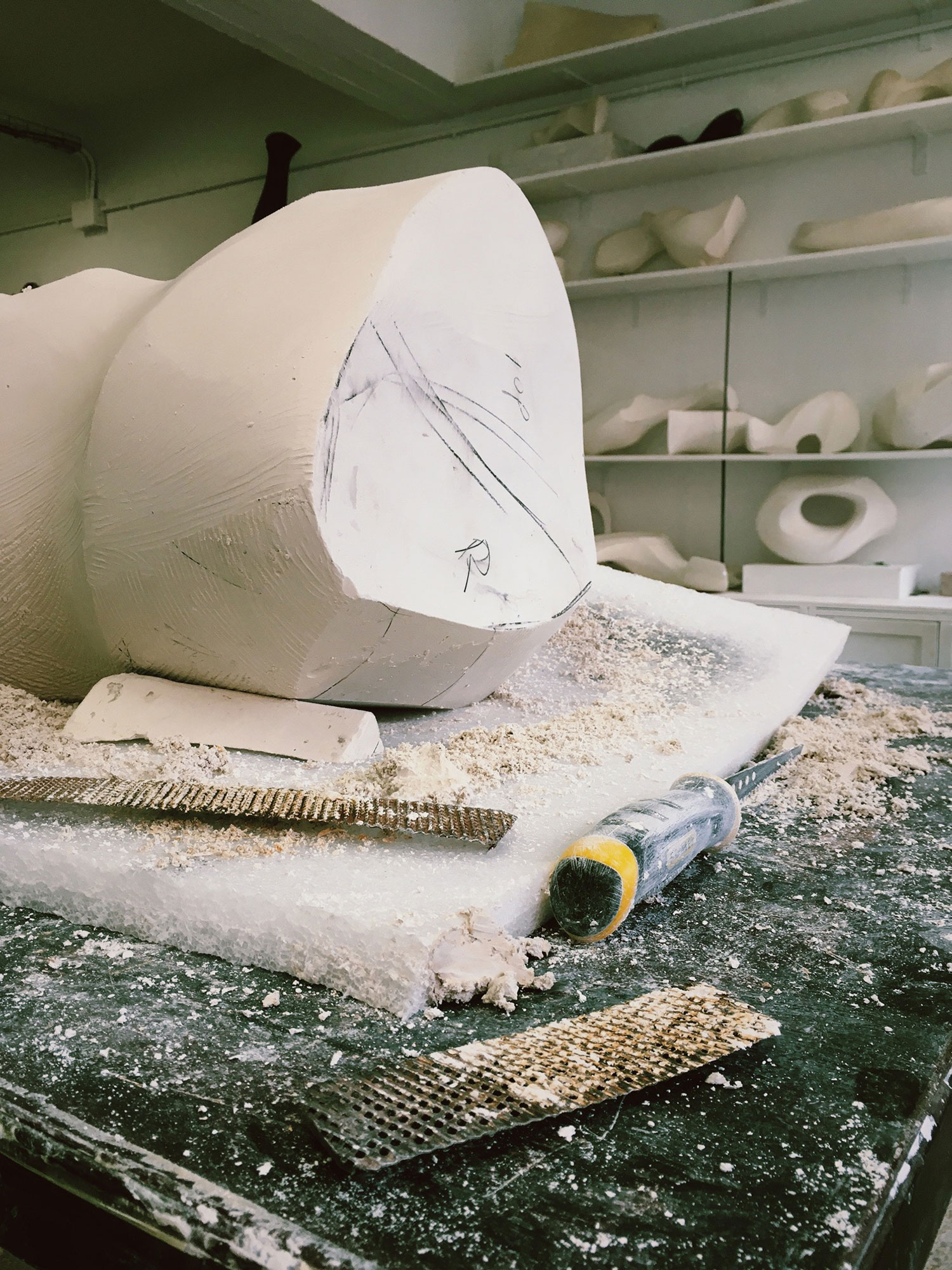
Somehow, they are parts of your sculptures that connect you directly to emotional and personal parts, is that right?
I can really close my eyes and feel her, this is Floss. And there’s another sculpture over there. Those round ones. They also have that little piece underneath. You touch it and that’s definitely her as well. So I see bits after I’ve made a sculpture and I think, oh, that’s interesting. Well, that’s where that comes from.
How nice to be able to pet your dog’s stomach in your pieces. I’m sure more people will get that feeling when they touch your sculptures and connect emotionally with a memory.
Yeah, yeah, yeah!
Completely. Completely!!
Your style is abstract but with very minimalist lines. Has there been a formal evolution in your work or have you always worked from this field?
Oh no, it has changed a lot. In fact, this print-relief clay piece you see here is from my degree course when I was at school, at the art college. And this was my creation. I went to study ceramics where they taught me the techniques of the wheel and throwing. And I hated it. I actually hated thowing. So my reaction to that was to make print-reliefs in clay and my way of doing my degree course was to make this piece which is figurative. I always loved drawing and it was like drawing in clay. I have my drawing table there, so I always did it.
And so it was very literal. It was very figurative. I went from doing a lot of life drawings and drawing a lot of people in the street and generally observing people. During my time at university I had the opportunity to go to Malaysia for a month with my sister and it completely woke me up. I wasn’t doing very well at university to begin with. I was just playing and not really finding my way. And after that, I just drew a lot. And these are all the people that I drew in Malaysia, I submitted a lot of pieces to hang on the wall. So a lot of these some of them were much bigger as well. And I like the idea of them being, you know, they were ceramic, but they weren’t a functional piece either. They were a print, but they weren’t really a print either. And they just are. So it’s gone from there.
I always thought of myself as a sculptress, but I just didn’t know how to get away from just making out of clay.
Since that time I’ve been making with help, pieces with stone and casting in resin. And now I’m starting to explore bronze as well, which is something I’ve always wanted to do.
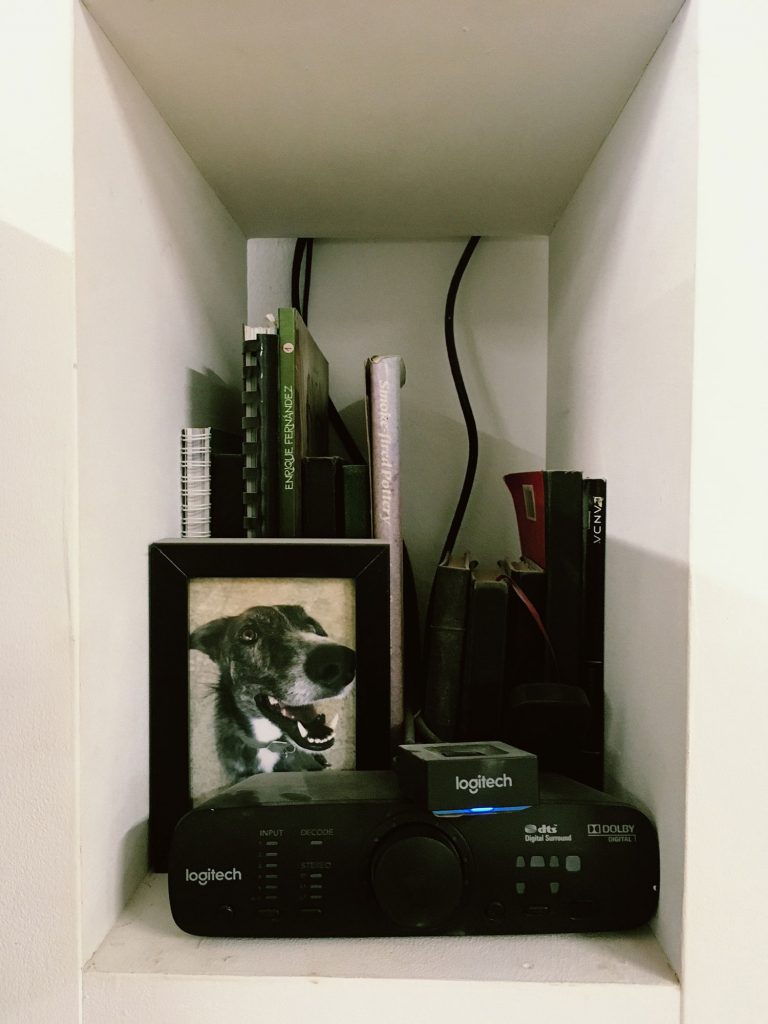
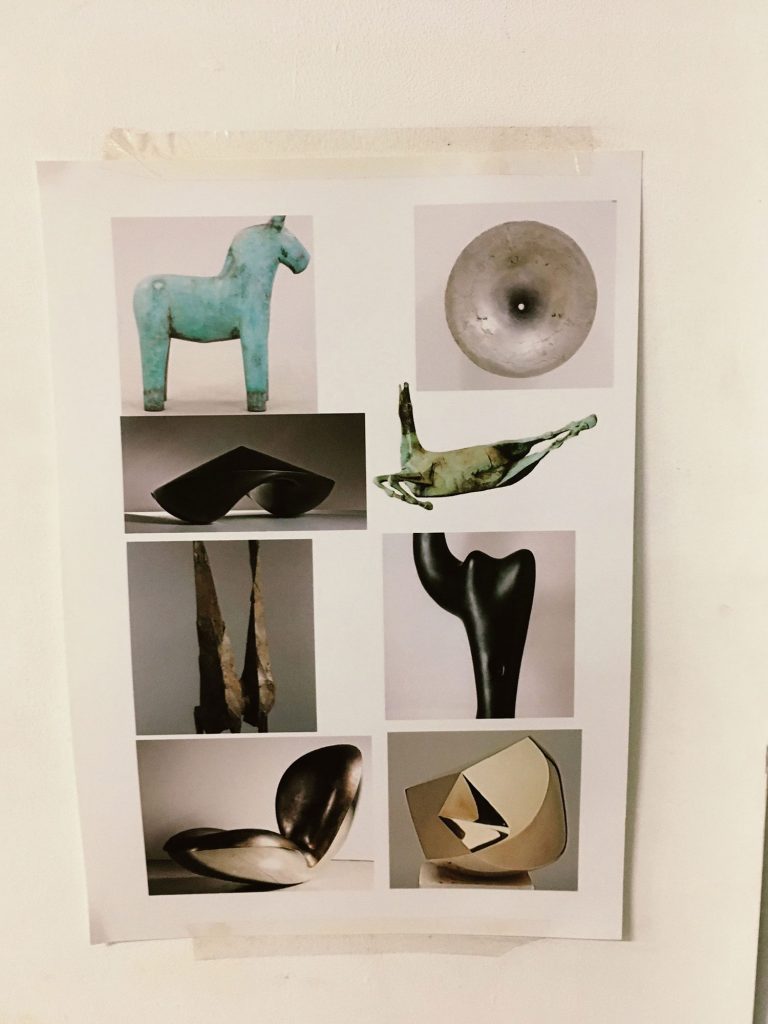
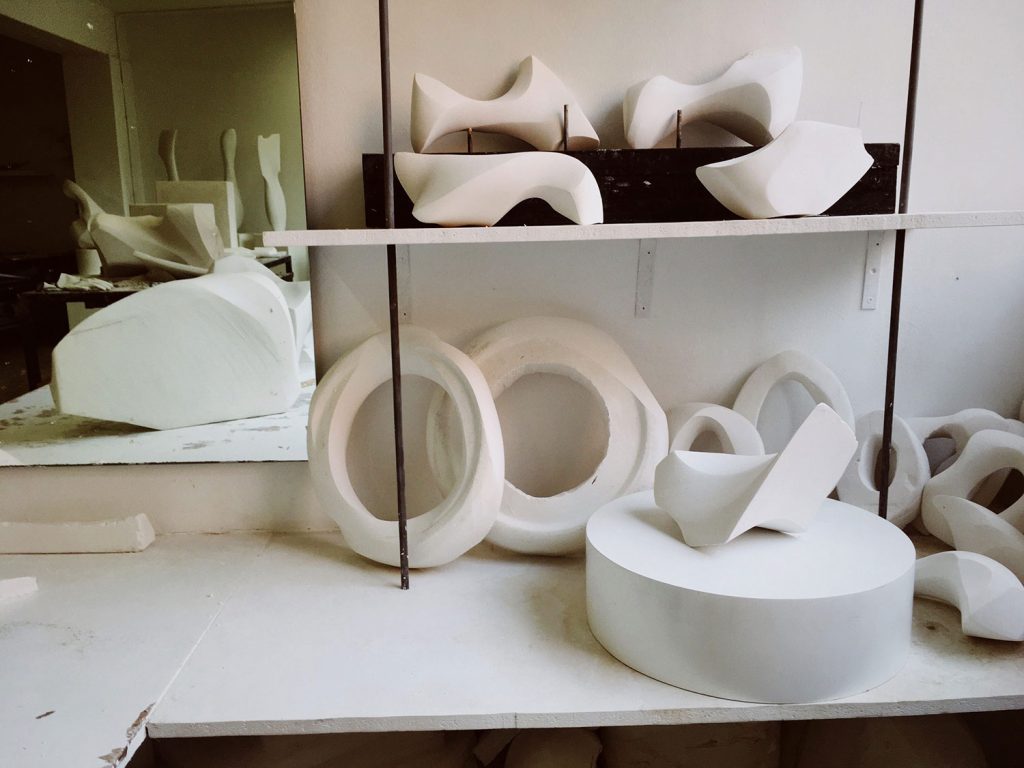
So these works in stone, bronze… are they made by people from here or do you go to another country, for example Italy, because of its marble culture?
All the people who help me are from here, so all of my suppliers are all Catalans. Granits Barbany help me create my stone pieces. These guys are one of the teams that work on the Basilica of the Sagrada Familia. I also work with another team in Shanghai which is an Australian company, they are two guys and they help the sculptors to make large sculptures. But when I work with them it’s exclusively for their clients. I don’t currently make them there and then send them somewhere else. One of the current projects is working for a client of theirs for the Hainan Hotel in southern China and they are doing this huge sculpture in Polish steel. So I sent them a scan and I totally trust their work, they’re the only ones I would do this with, normally every year I go and visit them and work with them and all that. But because of the pandemic, I haven’t been able to go, they’re still locked up in the South, so at the moment it’s impossible for me to travel to Shanghai.
Who inspires you in the art world? And outside it?
Well outside, I’m very inspired by architects, yeah, in architecture like Zaha Hadid is an obvious one to say. Calatrava is obvious as well, I suppose. I also really like architecture because I think of my sculptures in a space as well, so I find it inspiring.
I always think about my sculptures being on a larger scale. I always think about them being big. I think of people walking among them with sculpture surfaces above their heads, for example. I don’t think of them to be the size that you see my sculptures that you see in the studio, but I see them on a large scale.
So you always conceptualise them to be in a public space.
Exactly!
And from the art world, those are the ones that are with me on my bookshelf, where you find Henry Moore or Brancusi, obviously who else? Actually when I was probably eight years old or something like that, when I was little, probably Picasso, again they’re all really obvious because those are the influences I had from the beginning. But Tàpies is a big influence. In fact, he’s the reason I came to live here. I love his work. His work comes from a Zen look and that kind of thinking. I’m not thinking from Zen. There’s maybe more Taoism, but it’s the present moment. It’s that the gap between thoughts.
Who else? Anish Kapoor.
Yeah. I went to Venice this year, to the Biennale and I went, Yeah. He had an exhibition in, in this building, which was amazing. Well, it’s his building actually, since he seemed to have bought it and he’s created an Anish Kapoor foundation by the Grand Canal in Venice, he comes here often, they said.
Who else? Rauschenberg, Richard Deacon too. Again, the Brit. Who’s that? Oh, God. I’m going to have a look. Let’s go over there. I can see them in my in my head but. Anthony Gormley, also Modigliani. Auguste Rodin, who was an influence from a very early age. The one I’m thinking of the Japanese I went to see his house once. Where is his work? Here it is. Noguchi. Isamu Noguchi.


Have you been to his museum in NYC?
No, I went to his museum in Japan. So it’s probably better, I was able to visit his house too, well, I don’t know.
I’m sure you did, he also lived for a few years in New York.
Basket drawings, a lot of paintings and stuff. But also, actually, a major influence is also Chinese watercolours and calligraphy for my drawing. I don’t really work with colour. So it’s kind of an inspiration.
I have seen the table where you have the charcoal drawings. Are they a complement to the sculptures, that is to say, do you use the drawings to draw the lines of the sculptures or are they different expressions?
Yes, it’s totally different. In fact, very often clients say to me, “Can we see the designs before you make them now?” And I just say no. “Why? can we see the designs before we create a sculpture?” And I say, “Well, no, I don’t, I don’t design.” I don’t think like a designer. I find it actually the most personal and the most challenging because the one that means the most is drawing, actually. And it’s that I have to really get out of your own way to be able to draw.
Many times they also ask me for photographs, like in the project I am working on for a commission and they are learning to be patient with me, because they want photos and I send them photos, but I warn them not to look at them too much thinking that this will be the sculpture, because the sculpture is going to change and I don’t know when it will be finished. Explaining that to someone who doesn’t really understand the sculpture process can be a challenge for them I think.
And actually and at the moment you can see that I haven’t been drawing recently that much because they’re quite small. I’ve been so dedicated to doing sculpture that I really want to get back to drawing, I’d actually like to, you know spend time doing much bigger drawings. But I’ve had some drawings sitting here, like I’ve been building up to it.
And do you sell your drawings or are they part of your personal creative work?
No, they’re all just for me. I haven’t been trying to sell the drawings because I feel like I want to do more with them, but it’s something I will do. When I was in my previous studio in the Freixas building, I used to sell my drawings and since then, I haven’t. I guess it’s the head space. Since then I’ve concentrated on being a sculptress. And all that goes with it. But now I’m starting again. I have people as assistants who help me also to take some of the pressure off me to do other things, I have paper to draw on, charcoal…. So there’s no excuse. It’s not difficult for me. So no, it’s two things that are completely separate. Although I probably look at it and in the meantime, I make a sculpture.
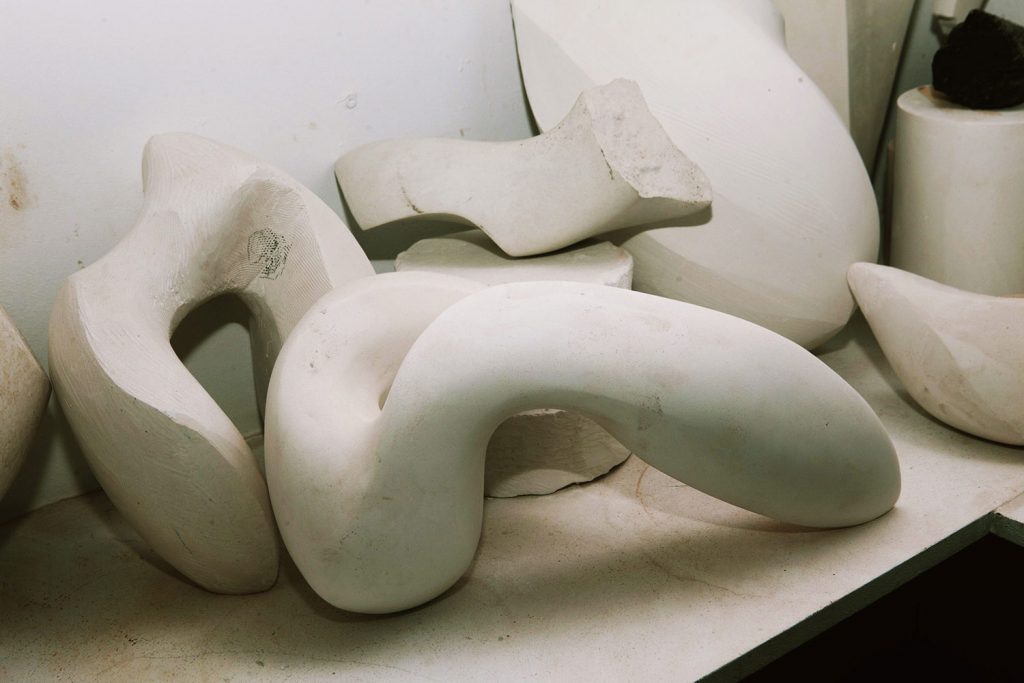
When did you decide to move to Barcelona?
It was all because of a visit I made to Barcelona to see a retrospective that was being made of Antoni Tàpies, who has always fascinated me, the exhibition was at the MACBA and Barcelona inspired me. And just thought, why not? you know, what’s the worst can happen? Just go back.
At that time you were living in London, weren’t you?
Yes, I studied in Bath, moved to London, then back to the West Country, back to Bath, moved to Bristol and then to Wales. And it was when I was living in Wales that I realised that, well, this isn’t right, okay? It wasn’t right and I thought, okay, okay, where do you go now, where do you go after that, where do you go to after London? And then Tàpies and his city, Barcelona, came along. The countryside is beautiful and I’m, I’m still a country person at heart, really. So it’s got a beautiful countryside, it’s got a great culture, you know, the values here are good. People respect, you know, friends, family, holidays and I don’t know. So it was liberating. Liberating to become the artist that I was supposed to be.
Let’s go back to your creative process. What elements or atmosphere do you need to find the perfect climax?
I like peace. Actually my assistant comes here in the mornings and helps me with the sculptures and helps keep the studio clean and tidy, among other things, he’s great. And then at lunchtime he leaves and I have the afternoon to myself. I need that time and it’s not because he’s distracting me, I don’t know, but sometimes he’s using a cutting machine or doing something and I just need that space of time without having that movement around me.
I tend to put on music, anything that helps me switch off, so I don’t think. Then I start carving, I’m working on all sides and I’m turning the piece and, you know, I just have to get lost in the piece and enjoy it.
What do you like to do when you are not in your studio? Do you have any hobbies?
This is my hobby too, I mean I do what I am passionate about and it is my main hobby at the same time. Apart from that, I love reading, I do meditation and my work-out every morning, walking in the countryside, at weekends I go out in my car and I take my dog for a walk outside in the countryside. Probably, if I didn’t have a dog, I would go cycling, I really like riding a bike, but I don’t do any of this. I enjoy the time to disconnect with friends, reading a book, watching a film or walking. Yes, exactly. Yes, I don’t have time for any other hobby. I do, but I don’t take the time to do it. I also like cooking very much, it’s something that also relaxes me a lot.
Which cuisine do you like to cook, English style or Mediterranean?
English cuisine? hahaha, be careful, it’s very good now, not like in the seventies.
Do you like Spanish omelette?
Yes, yes! it’s a good way to integrate, otherwise, you wouldn’t be well accepted, hahaha.
Do you have a place in the world where you would like to see one of your sculptures? Why there?
Ah, yes! Good point. Lots of places I think. I think in some amazing building like the Tate Modern would be amazing. That’s a good one, isn’t it?
I was thinking also about David Chipperfield in the incredible building he did for a museum in Berlin, The Neues Museum, the incredible space and also the museum. I’ve been thinking about this recently. That’s why I’m thinking about museums. It’s not my goal. But just because the spaces are amazing. But actually, for me, it’s also, you know. It would be amazing to have sculptures in a space in cities where really the interplay between the architecture and the spaces are amazing. And I also really like if you can put a sculpture in a space and change the way someone walks past and sees the space or feels in the space, it’s like it gives them a moment of presence.
Always in cities? Because I can imagine one of your sculptures in the countryside, in the middle of a forest and walking through nature and finding a piece of yours integrated in the forest.
Yeah, yeah! So. Okay. Yeah, let’s go with that.
If you couldn’t make a living from sculpture, what other profession would you like to do and why?
If I couldn’t make a living from sculpture, I would…um er, um er…..I need to think about this. For years, I worked as a temp, working in offices as a personal assistant or a legal secretary, but I always had a studio space and would work in my studio by night before returning to the office in the day. This is a difficult question, I really don’t know as Art is my plan A, my purpose and I’ve done everything to get to where I am today. Art is my form of subconscious expression, where and how else would that come out, I don’t know.
